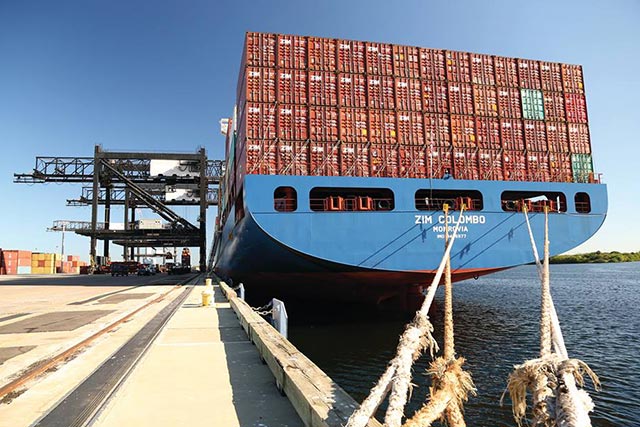Port Tampa Bay Still Finding Its Way as Expanded Panama Canal Opens

After years of buildup, the widened Panama Canal opened June 26, but Port Tampa Bay still finds itself struggling to see where it fits in.
To stand out, Port Tampa Bay spent $21.5 million for two post-Panamax gantry cranes to help grow its cargo container business. The port plans to start construction on a 130,000-square-foot cold storage food products facility that should be operational by next year. And officials are still trying to lure new car business from manufacturing plants in Mexico.
But the port has some stiff competition. It's up against ports that handle more than double the tonnage in Miami, Fort Lauderdale and Jacksonville and have established container businesses. Port Manatee, just south of the Sunshine Skyway bridge, has a strong refrigerated storage business, and Port Canaveral just signed a tenant to run its own new car import business from Mexico.
RELATED: Port Tampa Bay Cargo Drops, Mirroring Global Trend
"We recognize that this isn't a moment where a light switch turns on and everything changes," said Paul Anderson, CEO of the Tampa Port Authority. Anderson was among the many who flocked to Panama on June 26 to celebrate the opening of the $5.4 billion expansion of the Panama Canal. "There are contracts in place for some routes already, and we hope that, with our new cranes, we can handle larger vessels in the coming years as those contracts come to term."
Port Tampa Bay is working against the odds. It hopes to lure new long-term business opportunities at a time when its bulk cargo statistics are down, and it's just beginning to build a container shipment business.
"Ports are cannibalizing each other by going after the same business opportunities," said Richard Wainio, who ran Tampa's port until Anderson arrived in 2012. "Florida has dozens of ports, unlike other states that may have just one. There's not enough business anymore to justify how they all want to grow."
The recent widening of the Panama Canal was designed to accommodate a new generation of larger cargo ships. Local port officials hope those fleets will boost growth in the years to come.
But some analysts say there's no guarantee that's going to happen.
"This is not an immediate game changer," said Jim Kruse, director of Texas A&M University's Center for Ports and Waterways. "No one really knows yet just how this is going to affect the trade industry. You can build a canal, but that doesn't generate one more widget to sell or a brand new economy."
This new fleet of enormous cargo containerships coming from Asia won't come to Tampa Bay, analysts say. Most of them won't even come into the Gulf of Mexico initially. They will continue to go to the bigger established ports along the East Coast — Miami; Savannah, Georgia; Charleston, South Carolina; and New York. These ports and others have been preparing for the opening of the expanded canal by dredging deeper waterways and making room for more business.
Most of the goods that come to Florida today arrive by rail or truck. Most of the nation's goods are transported by rail and truck from bigger ports on the West Coast. Analysts say it's unlikely that will change because of the canal expansion.
"We don't know how the railways and West Coast ports are going to respond to this yet," Kruse said. "A lot of the nation's goods are coming across by rail." But railroad companies and ports in major cities such as Los Angeles could offer more competitive pricing and delivery routes to keep business.
"Then anything could happen," Kruse added.
Officials with Port Tampa Bay have marketed it as a gateway to central Florida, where megaretailers such as Wal-Mart Stores and others operate distribution warehouses. An expressway connection has eased truck traffic moving from the port to the local highway system.
Most of Port Tampa Bay's cargo routes come from the Caribbean and Latin America, but shipments have been down so far this year. Citrus juice, ammonia, phosphate and coal suffered the steepest declines this year during the first and second quarters. Historically, they have been some of the port's largest commodity imports.
Florida also exports very little, which is another factor to consider when attracting bigger containerships. Most of the bigger shipments headed into or out of Port Tampa Bay make several stops on the way, either delivering half of their cargo at another destination or picking up more somewhere else on the way back. The process is called transshipment.
"Ships don't want to go back empty. Knowing this, most containerships will pick only one port in Florida to stop at and move on to somewhere else," Wainio said. "This costs money and takes more time and doesn't create any new jobs."
At a recent master plan workshop, Jim Brennan, a partner with Capstan Consulting, warned the Tampa Port Authority's board of directors that it's hard to plan for the future in an industry that is inherent with risk. His forecast for the port's future calls for lower growth prospects in most core bulk businesses.
So officials are looking for new avenues for growth.
"We've never not been in a competitive market or competing with other ports," Anderson said. "We have some advantages that we think we're bringing to the marketplace and hope that other companies that are interested in serving the growing central Florida market see that, too."

